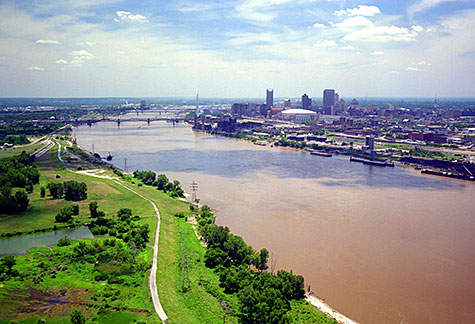
In the political realm, climate change remains a point of debate. But for architects, engineers, urban designers and others charged with managing its effects — the storms and floods that are followed, whiplash style, by drought and water scarcity — the evidence is in.
It’s time to develop a strategy, and to learn from those already implementing one.
“The climate has changed,” said John Hoal, PhD, associate professor and director of the Master of Urban Design program in the Sam Fox School of Design & Visual Arts. “We take it as a fact. The question is, how do you design for this new condition?”
From March 22-25, the Sam Fox School — in conjunction with The Royal Netherlands Embassy in Washington, D.C.— will present MISI-ZIIBI: Living With the Great Rivers, an international symposium investigating climate adaptation strategies in the Mississippi and Missouri basins.
“The Dutch have centuries of experience living with water,” said Dutch Ambassador Rudolf Bekink. “By joining with Washington University, we combine the best of Dutch ingenuity in water management with American experts in spatial design.
“Together we can chart a sustainable course for the Mississippi River that will continue to benefit the Midwest and the entire U.S.,” Bekink added.
Robbert de Koning and Steven Slabbers, both esteemed landscape architects and designers from the Netherlands, and Dale Morris, senior economist for The Royal Netherlands Embassy, will present a keynote lecture at 6:30 p.m. Friday, March 22.
The talk, which is free and open to the public, will explore “The Room for the River Program”— an eight-year, €2.3 billion ($3 billion) effort to address landscape design, climate change, flood protection, drought tolerance and environmental conditions in The Netherland’s Rhine-Meuse Delta.
Additional events will include panel discussions and scenario-planning workshops with dozens of experts from The Netherlands and the American Midwest.
Extreme flooding to extreme drought
The world’s fourth-longest river, the Mississippi drains 31 states (approximately 40 percent of U.S. landmass) and is a primary conduit for agricultural export. Yet increased climate volatility, as evinced by the 2011 floods and the 2012 Midwest drought, threatens to impede the river’s functioning as well as the use of adjacent lands.
“In the space of one year, we’ve gone from extreme flooding to extreme drought,” said Hoal, who organized MISI-ZIIBI with Derek Hoeferlin, assistant professor of architecture. “So now we’re looking at both conditions.”
“When water is high, what are the implications for building in the flood plain?” Hoal continued. “When water is low, what is the impact on agriculture? How do you get barges through? How does it impact ground water and water quality?
“The sense that, because we’re surrounded by this amazing river system, we’ll never have a water problem — well, it’s not true,” Hoal said. “And it’s really shocking.”
Morris noted, “These same challenges are also present in the Netherlands, in which 60 percent of the people live in, and 70 percent of GDP is generated in, land and cities that are at or below sea level.”
A prototypical Midwestern situation
A former director of urban design for the City of St. Louis, Hoal is founding principal of H3 Studio and directed master planning for the 200-square-mile Confluence Greenway System. He and Hoeferlin have worked together on water management issues, notably in post-Katrina New Orleans, where H3 was one of five firms leading the Unified New Orleans Plan.
Hoeferlin was part of the Dutch Dialogues in New Orleans, which led to the ongoing development of a comprehensive urban water management strategy for the Crescent City by a multidisciplinary Dutch-American team.
“St. Louis is a great example of a prototypical Midwestern situation,” Hoeferlin said. Workshops (which are by invitation) will pair Dutch experts from Room for the River with stakeholders from throughout the Mississippi and Missouri basins. Together, they will examine three distinct conditions:
* An agricultural zone, represented by the Mississippi from Melvin Price Locks and Dams to the Illinois confluence.
* A suburban development zone, represented by the Missouri from Earth City to the Chesterfield Valley.
* An urbanized zone, represented by the Mississippi from the Missouri confluence to Interstate 270.
“Throughout the Midwest, you see all three types,” Hoeferlin said. “But St. Louis also represents a unique transitional zone, where you go from a managed system of locks and dams to a free-flowing river.
“We’re trying to think about the watershed as a whole,” Hoeferlin added. “What’s the relationship, the cause and effect, between what happens upriver versus what happens downriver?”
Not one solution
Concluding the four-day conference, at noon Monday, March 25, will be a series of public presentations by the three working groups. Offering reflections will be Rachel Jacobson, the Department of the Interior’s acting assistant secretary for Fish and Wildlife and Parks.
“We’re not trying to come up with one solution,” Hoal said. “We’re trying to come up with a series of strategies and tactics that can be applied throughout the upper Midwest, in a variety of conditions. We’re sure that our Dutch colleagues can contribute to those strategies, and maybe also take some good ideas back to their own country. The workshop is a great example of cross-boundary and cross-discipline collaboration.”
“Over the next 30 years, the costs of replacing levees and rebuilding the river system will be astronomical,” Hoal continued. “It’s unaffordable. Something has to change.”
Hoeferlin concluded, “We can’t keep simply reacting to crisis. We need to learn to be proactive.”
Locations and sponsors
“MISI-ZIIBI: Living With the Great Rivers” takes place in the Sam Fox School’s Steinberg and Givens Halls, located near the intersection of Skinker and Forsyth boulevards.
For more information or a complete schedule of public events, visit http://www.samfoxschool.wustl.edu/events/lectures/7854.
Support for MISI-ZIIBI is provided by American Rivers; Southern Illinois University Carbondale; the CGI U Programming Fund at WUSTL’s Gephardt Institute for Public Service; and WUSTL’s International Center for Advanced Renewable Energy and Sustainability.